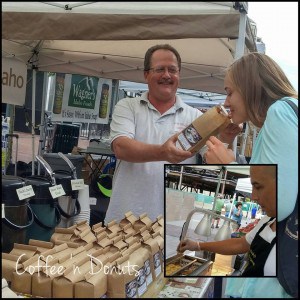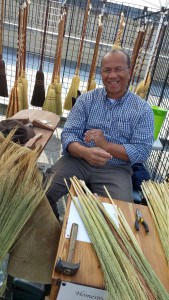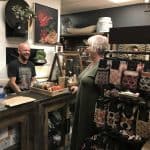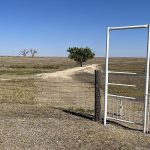
Rolling pins by SJ Woodworks offered for sale at Capital City Public Market. Photo by Melissa Nodzu, used with permission.
How to Wow the Big Town Farmer’s Markets, even if you’re not a farmer
Guest Post by H. E. James
Small town businesses like yours can often be limited in audience and market. Depending on how isolated your community is, it can be difficult to do business outside the community without simply going online.
E-commerce sites like Etsy are a great way to get started when you’re a small town business owner looking to sell handmade goods. My own parents live in a rural area and are jewelers and artisans who travel outside their community to market their products. Getting offline at art shows and farmer’s markets in larger communities has proved to be great exposure for them and many others, but it does take some finesse.
Logistics

Brett “Buzz” Davis of Long Valley Coffee travels a long way to Capital City Public Market. Photo by Melissa Nodzu, used with permission.
In the case of the farmer’s markets in my hometown area, the two with the most exposure are at least 45 minutes away from most rural areas. Set-up starts early at both of them, with loading opening around seven in the morning. So first and foremost, you must decide if it’s worth the time and effort to visit a farmer’s market, which you should do as regularly as possible for the best return on investment.
When you’re carrying in products that require you to set up displays or require the set-up of electricity, you have to plan your day down to the minute. For vendor BuckSnort Sodas, that was definitely the case. Their trip to Boise, Idaho’s Capital City Public Market (CCPM) would start from more than 150 miles away in Ketchum, almost three hours from the market.
The distance was worth it, as BuckSnort can now be found alongside beers and wines at restaurants and bars all over the state and even in Oregon. By starting small, sharing just one or two products at the market, BuckSnort was able to manage the logistics of travelling the long distance for the day. Its success has been so great that it has now moved closer to its main market: Boise.
Another CCPM vendor who travels a great distance each week is Brett “Buzz” Davis, owner of Long Valley Coffee. He and his son roast their own coffees and bring them to Boise from McCall, more than two hours away.
Know the Market
Secondly, you must think strategically about the market, and not just the one at which you’re going to sell your product. If you decide to sell at more than one in a given market, be sure to look at the demographics of your target market. Why is this important?
People in rural, suburban, and urban markets spend differently, and not just because incomes differ among them. Urban dwellers are likely to be exposed more often to what you are offering, so you must consider your products’ prices carefully. While you should always consider what it truly costs you to produce your work and price that work higher than expected, don’t forget to consider the wares of your competitors. As author Rochelle Bailis advises in her article on product pricing, it’s best to compare yourself honestly with your competition.
At the farmer’s markets in Boise, there are multiple honey growers who sell multiple products. Their prices are all relatively the same. What differentiates them from each other are things like packaging, specialty products, and even production location.
Leverage the Story

Ernie Garvin of Homestead Brooms, exhibiting at Capital City Public Market. Photo by Melissa Nodzu, used with permission.
Like the many wineries that sell their vintages at the Boise Farmer’s Market, or the honey producers at Capital City, if you are selling among multiple competitors, you have to find unique ways to differentiate yourself.
One way is to start with your story. Every business has a story. For rural lavender farmer and Capital City vendor Silver Fox Lavender, that starts with the history of the farm itself. The owners live in a century-old Sears mail-order farmhouse, and it is featured on their packaging and the banner that it is displayed at the market booth.
If your product is unique from other sellers at the farmer’s markets, make that a feature of your booth presentation. Big Lost River Meats travels all the way to Boise from Mackay every Saturday for the Boise Farmer’s Market. This round-trip of 440 miles is worth it because they typically sell out within the first couple of hours. Their no-preservatives, specialty sausages and game salami can’t be found among other vendors at that market.
All About You
Taking your small business to a farmer’s market in a larger community can be a gamble if you’re not prepared, but it can pay off in the long run. Marketing your goods online is a great way to get started as an artisan or producer. Yet it can be an impersonal experience for small business owners who are used to interacting with friends and neighbors in rural neighborhoods.
Marketing at a larger-scale farmer’s market is a great way to translate the social aspect of small town business to big town sales and growth. Take what makes your business unique and head to the market. Do it right, and you’ll be successful!
Photos of vendors at Capital City Public Market, taken by Melissa Nodzu, and used with permission.










